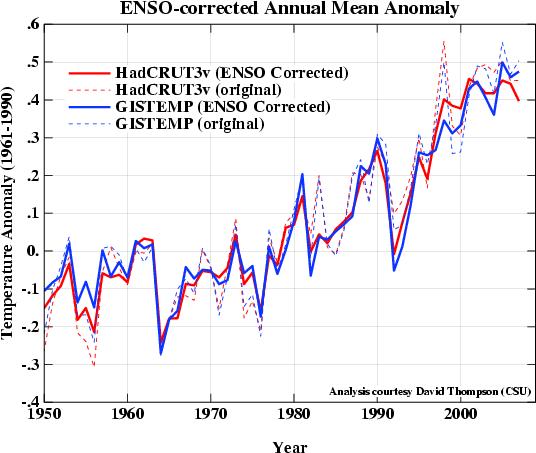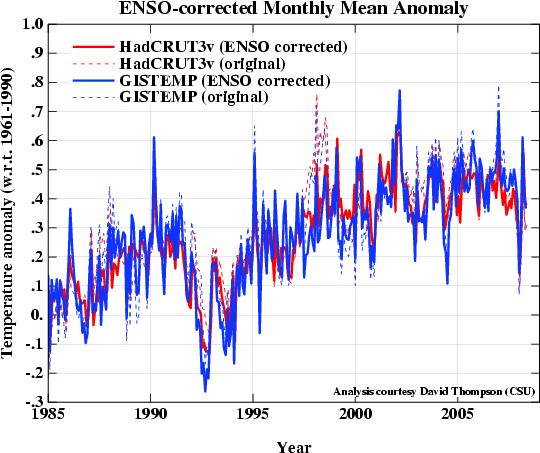"Global trends and ENSO" by Gavin Schmidt
It's long been known that El Niño variability affects the global mean temperature anomalies. 1998 was so warm in part because of the big El Niño event over the winter of 1997-1998, which directly warmed a large part of the Pacific and indirectly warmed (via the large increase in water vapour) an even larger region. The opposite effect was seen with the La Niña event this last winter. Since the variability associated with these events is large compared to expected global warming trends over a short number of years, the underlying trends might be more clearly seen if the El Niño events (more generally, the El Niño-Southern Oscillation (ENSO)) were taken out of the way. There is no perfect way to do this -- but there are a couple of reasonable approaches.
In particular, the Thompson et al. (2008) paper (discussed here) used a neat way to extract the ENSO signal from the SST data by building a simple physical model for how the tropical Pacific anomalies affect the mean. He kindly used the same approach for the HadCRUT3v data (pictured below), and I adapted it for the GISTEMP data as well. This might not be ideal, but it's not too bad:


(Each line has been re-adjusted so that it has a mean of zero over the period 1961-1990.)
The basic picture over the long term doesn't change. The trends over the last 30 years remain, though the interannual variability is slightly reduced (as you'd expect). The magnitude of the adjustment varies between +/-0.25ºC. You can more clearly see the impacts of the volcanoes (Agung: 1963, El Chichon: 1982, Pinatubo: 1991). Over the short term though, it does make a difference. Notably, the extreme warmth in 1998 is somewhat subdued, as is last winter's coolness. The warmest year designation (now in the absence of a strong El Niño) is more clearly seen to be 2005 (in GISTEMP) or either 2005 or 2001 (in HadCRUT3v). This last decade is still the warmest decade in the record, and the top 8 or 10 years (depending on the data source) are all in the last 10 years!
Despite our advice, people are still insisting that short-term trends are meaningful, and so to keep them happy, standard linear regression trends in the ENSO-corrected annual means are all positive since 1998 (though not significantly so). These are slightly more meaningful than for the non-ENSO corrected versions, but not by much -- as usual, corrections for auto-correlation would expand the error bars further.
The differences in the two products (HadCRUT3v and GISTEMP) are mostly a function of coverage and extrapolation procedures where there is an absence of data. Since one of those areas with no station coverage is the Arctic Ocean (which, as you know, has been warming up somewhat), that puts in a growing difference between the products. HadCRUT3v does not extrapolate past the coast, while GISTEMP extrapolates from the circum-Arctic stations -- the former implies that the Arctic is warming at the same rate as the rest of the globe, while the latter assumes that the Arctic is warming as fast as the highest measured latitudes. Both assumptions might be wrong, of course, but a good test will be from the Arctic Buoy data once they have been processed up to the present and a specific Arctic Ocean product is made. There are some seasonal issues as well (spring Arctic trends are much stronger than summer trends since it is very hard to go significantly above 0ºC while there is any ice left).
The ENSO-corrected data can be downloaded here. Note that because the correction is not necessarily zero for the respective baselines, each time series needs to be independently normalised to get a common baseline.
Link to RealClimate post: http://www.realclimate.org/index.php/archives/2008/07/global-trends-and-enso/







4 comments:
What do you reckon about Lucia's response?
I have not seen it.
Here. (I do wish Gavin would just link to her or better still just engage with the woman. We'd all learn a lot more that way.)
Gee, I dunno, Bishop. I am still trying to figure out how to calculate a climate trend using 7 years of data.
Post a Comment